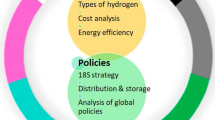Abstract
In recent decades, interest in hydrogen energy has undergone significant fluctuations. The current round of development is associated with the growing concern about climate change and the emerging trend of decarbonization of the world economy, including transport and energy, which are one of the main sources of atmospheric pollution with carbon dioxide emissions. Moreover, in several countries there is a widespread introduction of renewable energy sources with a stochastic nature of power output, requiring redundancy and the use of efficient energy storage devices to regulate energy generation and consumption schedules. The article presents a brief analysis of the trends in the development of hydrogen energy in the world and in Russia. Attention is drawn to the fact that the prospects and scale of hydrogen energy development will largely depend on the features of the proposed hydrogen sources, primary energy sources and hydrogen production technologies, environmental consequences when using different approaches to hydrogen production (“carbon footprint”), expected costs for hydrogen production, potential consumers and volumes of hydrogen consumption within the country and abroad, technologies for storing and delivering hydrogen to consumers, and the competitiveness of hydrogen as an energy carrier in the domestic and foreign markets, taking into account all necessary costs and a potential “trans-border carbon tax.”

Similar content being viewed by others
REFERENCES
Technology Roadmap. Hydrogen and Fuel Cells, IEA, 2017. www.iea.org/reports/technology-roadmap-hydrogen-and-fuel-cells.
How Hydrogen Empowers the Energy Transition, Hydrogen Council, 2017. https://hydrogencouncil.com/en/study-how-hydrogen-empowers.
Falcone, P.M., Hiete, M., and Sapio, A., Hydrogen economy and sustainable development goals: Review and policy insights, Curr. Opin. Green Sustainable Chem., 2021, vol. 31, p. 100506.
Zhang, G., Zhang, J., and Xie, T., A solution to renewable hydrogen economy for fuel cell buses—A case study for Zhangjiakou in North China, Int. J. Hydrogen Energy, 2020, vol. 45, pp. 14603–14613.
Apostolou, D., Optimisation of a hydrogen production-storage-re-powering system participating in electricity and transportation markets. A case study for Denmark, Appl. Energy, 2020, vol. 265, p. 1148002.
Plan meropriyatii “Razvitie vodorodnoi energetiki v Rossiiskoi Federatsii do 2024 goda” (Action Plan on Development of Hydrogen Energy in the Russian Federation until 2024). http://government.ru/docs/all/130498.
CCUS in Clean Energy Transitions, IEA, 2020. www.iea.org/reports/ccus-in-clean-energy-transitions.
Filippov, S.P., and Dil’man, M.D., Technological renewal of Russian thermal power plants based on gas turbine technologies, Gazotrubin. Tekhnol., 2019, no. 2 (161), pp. 14–17.
Kosoi, A.S., Zeigarnik, Yu.A., Popel, O.S., et al., Conceptual diagram of a combined cycle plant with complete capture of carbon dioxide from combustion products, Teploenergetika, 2018, no. 9, p. 23–32.
Datsenko, V.V., Zeigarnik, Yu.A., Kalashnikova, E.A., et al., Combined cycle gas plants with total carbon dioxide capture for clean energy, Teplofizikaiaeromekhanika, 2020, vol. 27, no. 5, pp. 815–822.
Sinkevich, M.V., Borisov, Yu.A., Kosoy, A.A., et al., Analysis of the working conditions of the recuperative and heat recovery systems of a compressorless combined cycle gas turbine, AIP Conference Proceedings, 2019, vol. 2141, p. 030066. https://doi.org/10.1063/1.5122116
Sinkevich, M., Borisov, Y., Kosoy, A., and Ramazanov, E., Potential advantages of using compressorless combined cycles in power engineering, E3S Web of Conferences, 2020, vol. 209, p. 03022.
Sinkevich, M., Kosoy, A., and Popel, O., Comparative analysis of the Allam cycle and the cycle of compressorless combined cycle gas turbine unit, ENERGY-21. Sustainable Development and Smart Management, 2020. https://www.e3s-conferences.org/articles/e3sconf/pdf/ 2020/69/e3sconf_energy-212020_03023.pdf.
Sinkevich, M.V., Ramazanov, E.R., Borisov, Yu.A., et al., Analysis of the influence of parameters on the efficiency of the thermodynamic cycle of a compressorless combined cycle plant, Teplofiz. Vys. Temp., 2021, no. 5 (in press).
Matrenin, V.I., Ovchinnikov, A.T., Pospelov, B.S., Sokolov, B.A., and Stikhin, A.S., From the energy of the Buran spacecraft to the energy of spacecraft and stations, Kosm. Tekh. Tekhnol., 2013, no. 3, pp. 57–65.
Guandalinia, G., Forestia, S., Campanaria, S., Coolegemb, J., and ten Have, J., Simulation of a 2 MW PEM fuel cell plant for hydrogen recovery from chlor-alkali industry, Energy Procedia, 2017, vol. 105, pp. 1839–1846.
Funding
This work was supported by the Ministry of Science and Higher Education of the Russian Federation, State Assignment no. 075-01056-22-00.
Author information
Authors and Affiliations
Corresponding author
Ethics declarations
The authors declare that they have no conflicts of interest.
Additional information
Translated by E. Domoroshchina
About this article
Cite this article
Popel’, O.S., Tarasenko, A.B. Promising Directions for Hydrogen Energy Development in Russia. Appl. Sol. Energy 58, 152–158 (2022). https://doi.org/10.3103/S0003701X22010133
Received:
Revised:
Accepted:
Published:
Issue Date:
DOI: https://doi.org/10.3103/S0003701X22010133




